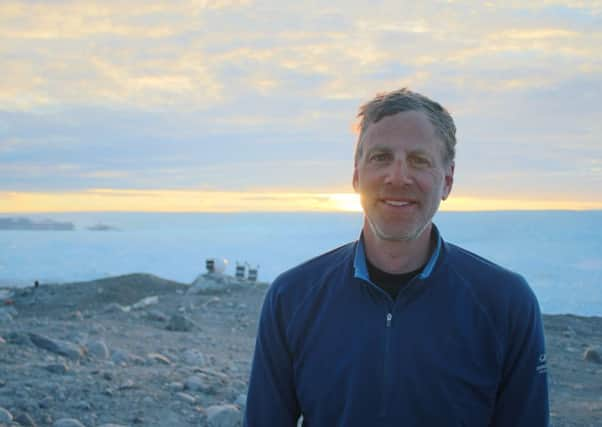What Greenland’s rapidly melting ice sheet means for the planet


The Greenland ice sheet is the northern hemisphere’s last large remnant of past ice ages, and the second largest ice sheet in the world after Antarctica’s. All told, it covers about 80 per cent of Greenland, the world’s largest island, and in its centre runs to a depth of about two miles. If all of Greenland’s ice were to melt, it would likely raise sea levels by around 24 feet. This will not happen anytime soon – certainly not in this century. But Greenland is melting at an accelerating rate, shedding, on average, about 280 billion tons of ice annually, which amounts to just under one millimetre of sea level rise per year. This past summer, several warm fronts stalled over the ice sheet, resulting in a meltdown that well exceeded those of a typical year. On just one hot day last August, the ice sheet, cut with meltwater rivers and azure lakes, lost about 10 billion tons.
Each summer for the past five years, I’ve travelled to Greenland to get a sense of how fast it is melting and what the implications might be. Sometimes, I had the good fortune to trail scientists and engineers working on NASA IceBridge missions; in other instances, I camped by crumbling glaciers with science teams trying to collect data on how Greenland’s ice sheet loses mass through huge icebergs that break off the edges and float away. To visit the ice is akin to visiting a vast frozen world where there is nothing – no towns, no trees, no roads – and only the occasional arctic fox or polar bear. There is nothing, that is, except ice, rock, and water.
Advertisement
Hide AdAdvertisement
Hide AdAs we go about our lives in Edinburgh – or, in my hometown of New York – the recent news about Greenland relates to how its wealth and resources might be exploited by countries such as the United States. Almost certainly, Greenland has vast untapped stores of minerals, metals, and oil, which is evidently the reason Donald Trump raised the possibility (aptly dismissed as “absurd” by Denmark’s leader) of buying the island. Yet what’s more important here is the vast potential for Greenland’s ice to disrupt civilization. The arctic is currently warming at about twice the rate of the rest of the world. As it heats up, the effects are becoming apparent in summer meltdowns like those that occur in Greenland, and in the diminishing sea ice that forms a floating, frozen cover over the dark Arctic Ocean. All told, the outlook for both is grim.
The biggest dangers relate to what we call feedback loops. Greenland’s ice sheet is more like a dome than a flat expanse, rising up 10,000 feet in its coldest central region. One of the measures taken by IceBridge flights each year is the elevation of the ice below the air routes. Along with satellite data, these readings show that the ice sheet in certain regions is beginning to thin dangerously. The concern is that the lower the ice sheet gets in elevation, the warmer the air that surrounds it. So the ice sheet melts; then it gets exposed to warmer temperatures at lower elevations. Then it melts some more.
A similar, repetitive process is unfolding in Greenland’s southwestern region, where the ice sheet is getting darker, due largely to dust and soot that have settled on the ice, and to algae blooms that spread in warmer temperatures. The effect is to lower the surface reflectivity and allow the ice to absorb more solar energy – thus melting it more and darkening it even further.
In sum, we might say that the more Greenland melts now, the more likely it is to melt more in the future. And the ultimate question is how long this ice will last – the same question, incidentally, that faces West Antarctica, where a number of massive glaciers also appear to be unstable. According to recent academic studies that use computer models to plot the fate of the ice sheets, Greenland’s ice could remain mostly intact for a thousand years. Then again, it may disappear completely in that time frame. These differing outcomes depend upon what we do next. Do we change course soon and address the warming trends in the Arctic by drastically curtailing our CO2 emissions? Or do we continue on the current path and watch the top of the world warm to where it passes a point at which its ice cannot be preserved? And do keep in mind: It doesn’t take 24 feet of sea level rise to drown a coastal city or island. An ocean that’s just a few feet higher, and a powerful storm blowing in from the sea, can wreak unimaginable damage, just as it did a few weeks ago in the Bahamas.
This wasn’t something I could necessarily foresee while flying over Greenland’s ice sheet several years back. On those long days in the plane, it was sometimes hard to imagine that so much of the ice below could be so vulnerable. And yet, the data doesn’t lie. The ice sheet, as we now know from air and satellite data, is going down, down, down. And the great challenge of the coming decade is to change that trajectory before it is too late – not only to save the ice, in other words, but more crucially, to save ourselves.
The Ice at the End of the World: An Epic Journey Into Greenland’s Buried Past and Our Perilous Future by Jon Gertner is out now, published by Icon Books at £18.99